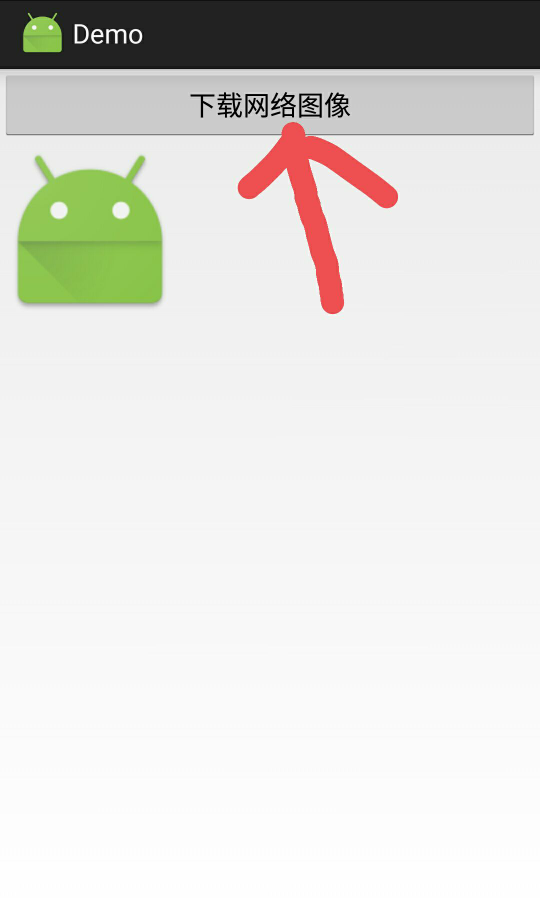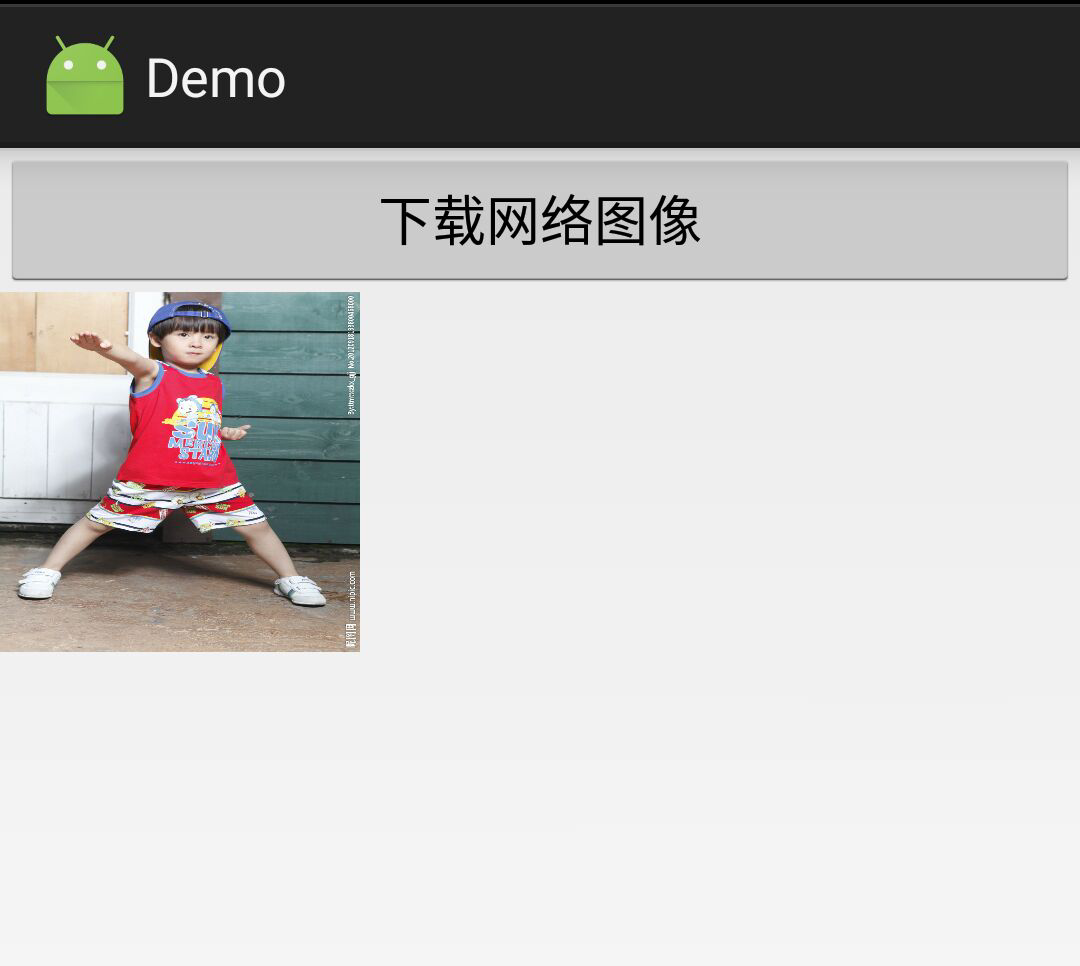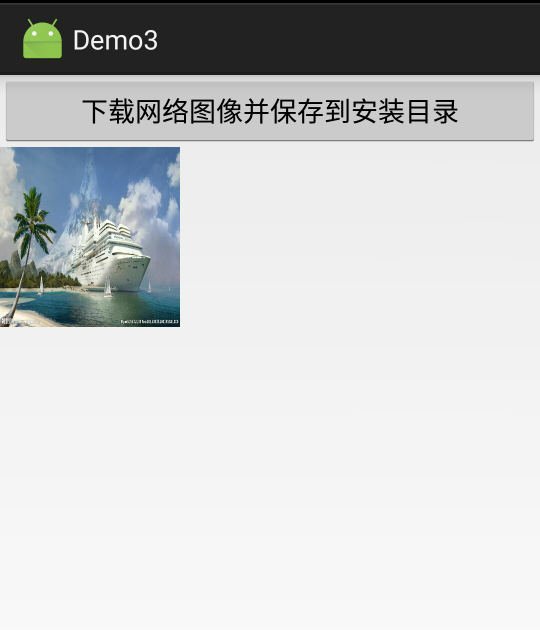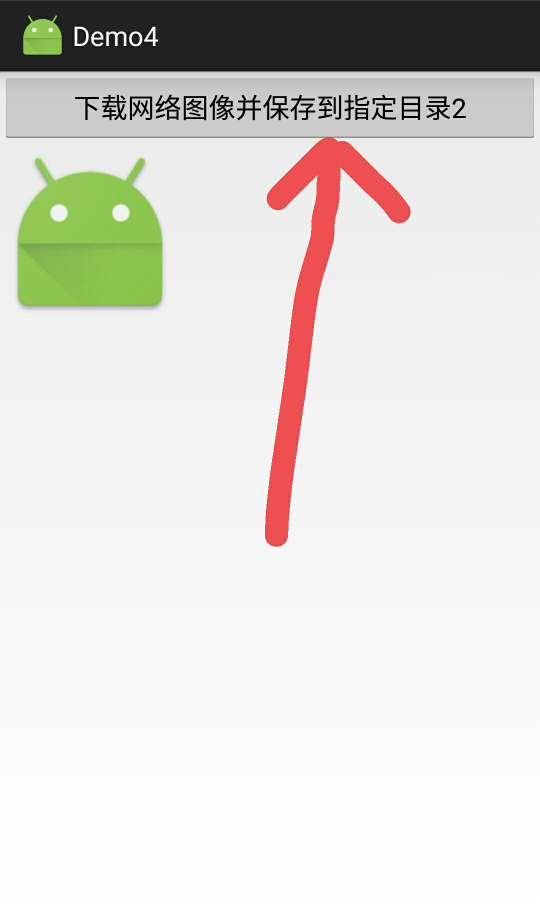Android开发 ---从互联网上下载文件,回调函数,图片压缩、倒转
效果图:
描述:
当点击“下载网络图像”按钮时,系统会将图二中的照片在互联网上找到,并显示在图像框中
注意:这个例子并没有将图片文件下载到本地


1、activity_main.xml
描述:
在主页上画一个“下载网络图像”按钮,和一个图像显示框
<?xml version="1.0" encoding="utf-8"?> <LinearLayout xmlns:android="http://schemas.android.com/apk/res/android" android:layout_width="match_parent" android:layout_height="match_parent" android:id="@+id/activity_main" android:orientation="vertical" > <Button android:layout_width="match_parent" android:layout_height="wrap_content" android:text="下载网络图像" android:onClick="downLoadImage" /> <ImageView android:layout_width="120dp" android:layout_height="120dp" android:id="@+id/showImage" android:src="@mipmap/ic_launcher" android:scaleType="fitXY" /> </LinearLayout>
2、MainActivity.java
package example.com.demo; import android.app.Activity; import android.graphics.Bitmap; import android.graphics.BitmapFactory; import android.os.Bundle; import android.view.View; import android.widget.ImageView; import java.io.InputStream; import java.net.HttpURLConnection; import java.net.URL; public class MainActivity extends Activity {
//获取图像框,但是还不知道是哪个id的图像框,所以在onCreate()方法中获取图像框id private ImageView imageView; @Override protected void onCreate(Bundle savedInstanceState) { super.onCreate(savedInstanceState); setContentView(R.layout.activity_main);
//取得图像框id imageView = (ImageView)findViewById(R.id.showImage); } //下载图像(注意:android4.0之后,所有的Web操作必须置于多线程之中) public void downLoadImage(View view){
//创建线程 new Thread(new Runnable() { @Override public void run() { try {
//构建一个URL,这个URL可以是互联网上的网址,如果要本地的网址,必须要知道本地计算机的IP地址 URL url=new URL("http://pic23.nipic.com/20120918/10910345_133800468000_2.jpg"); //构建一个URL(java.net)
//HttpURLConnection是java的标准类,继承自URLConnection类,它们都是抽象类无法实例化对象。
//通过URL的openConnection方法获得并创建连接 HttpURLConnection conn= (HttpURLConnection)url.openConnection(); conn.setConnectTimeout(10*1000);//设置连接超时时间 conn.setDoInput(true);//默认true,服务器响应到客户端的都是数据流 /*
conn.setReadTimeout(15*1000);//设置读取超时时间
conn.setDoOutput(true);//设置是否允许构建一个输出流向服务器传递数据,默认为false
conn.useCache(false);//设置是否使用缓存,POST不能使用缓存,即不支持POST方式
*/
//建立连接
conn.connect(); //获取服务器响应的数据流 InputStream input=conn.getInputStream(); //将数据流转换为一张图像,BitmapFactory位图工厂 final Bitmap bitmap= BitmapFactory.decodeStream(input); //关闭流 input.close(); //将图像设置到ImageView中 runOnUiThread(new Runnable() { @Override public void run() { imageView.setImageBitmap(bitmap); } }); } catch (Exception e) { e.printStackTrace(); } } }).start(); } }
3、AndroidManifest.xml
设置网络权限
要从互联网上通过数据流的方式下载数据需要设置权限
<?xml version="1.0" encoding="utf-8"?> <manifest xmlns:android="http://schemas.android.com/apk/res/android" package="example.com.demo"> <application android:allowBackup="true" android:icon="@mipmap/ic_launcher" android:label="@string/app_name" android:roundIcon="@mipmap/ic_launcher_round" android:supportsRtl="true" android:theme="@style/AppTheme"> <activity android:name=".MainActivity"> <intent-filter> <action android:name="android.intent.action.MAIN" /> <category android:name="android.intent.category.LAUNCHER" /> </intent-filter> </activity> </application> <!--开启网络权限--> <uses-permission android:name="android.permission.INTERNET"/> <uses-permission android:name="android.permission.MOUNT_UNMOUNT_FILESYSTEMS"/> <uses-permission android:name="android.permission.WRITE_EXTERNAL_STORAGE"/> </manifest>
效果图:
描述:
当点击“下载网络图像并保存到SD卡”按钮时,系统会将URL指定路径上的文件下载到本地SD卡上,
上面的示例中,只是从互联网上获取一张图片,并没有下载到本地,
而这个例子,则将图片文件下载到了本地SD卡上


1、activity_main.xml
<?xml version="1.0" encoding="utf-8"?> <LinearLayout xmlns:android="http://schemas.android.com/apk/res/android" android:id="@+id/activity_main" android:layout_width="match_parent" android:layout_height="match_parent" android:orientation="vertical"> <Button android:text="下载网络图像并保存到SD卡" android:onClick="downLoadImage2" android:layout_width="match_parent" android:layout_height="wrap_content" /> <ImageView android:id="@+id/showImage" android:src="@mipmap/ic_launcher" android:scaleType="fitXY" android:layout_width="120dp" android:layout_height="120dp" /> </LinearLayout>
2、MainActivity.java
package example.com.demo2; import android.app.Activity; import android.graphics.Bitmap; import android.graphics.BitmapFactory; import android.os.Bundle; import android.os.Environment; import android.view.View; import android.widget.ImageView; import java.io.File; import java.io.FileOutputStream; import java.io.InputStream; import java.io.OutputStream; import java.net.HttpURLConnection; import java.net.URL; public class MainActivity extends Activity { private ImageView imageView; @Override protected void onCreate(Bundle savedInstanceState) { super.onCreate(savedInstanceState); setContentView(R.layout.activity_main); imageView=(ImageView)findViewById(R.id.showImage); } //下载图像并保存到SD卡指定目录 public void downLoadImage2(View view){ new Thread(new Runnable() { @Override public void run() { try { URL url=new URL("http://pic23.nipic.com/20120918/10910345_133800468000_2.jpg"); //构建一个URL(java.net) HttpURLConnection conn= (HttpURLConnection) url.openConnection(); conn.setConnectTimeout(10*1000);//设置连接超时时间 conn.setDoInput(true);//默认true,服务器响应到客户端的都是数据流 conn.connect(); //获取服务器响应的数据流 InputStream input=conn.getInputStream(); //构建一个输出流,将下载的文件保存到SD卡指定位置 //构建要保存文件的位置
//指定SD卡上的绝对路径,然后将图片保存到这个绝对路径中 String path= Environment.getExternalStorageDirectory().getAbsolutePath()+"/gdnf_image/image_1.jpg";
//构建文件,将上面的绝对路径放进来创建文件 File file=new File(path);
//判断文件的状态,如果文件不存在,则创建这个文件 if(!file.getParentFile().exists())
//创建父级文件 file.getParentFile().mkdirs();
//否则,将这个文件放入输出流中读取该文件 OutputStream out=new FileOutputStream(file); byte[] bytes=new byte[1024]; for(int len=0;(len= input.read(bytes))!=-1;){ out.write(bytes,0,len); }
//刷新 out.flush();
//关闭输出流 out.close(); input.close(); //将下载到的图像显示出来 final Bitmap bitmap= BitmapFactory.decodeFile(path); //将图像设置到ImageView中 runOnUiThread(new Runnable() { @Override public void run() { imageView.setImageBitmap(bitmap); } }); } catch (Exception e) { e.printStackTrace(); } } }).start(); } }
3、AndroidManifest.xml
<?xml version="1.0" encoding="utf-8"?> <manifest xmlns:android="http://schemas.android.com/apk/res/android" package="example.com.demo2"> <application android:allowBackup="true" android:icon="@mipmap/ic_launcher" android:label="@string/app_name" android:roundIcon="@mipmap/ic_launcher_round" android:supportsRtl="true" android:theme="@style/AppTheme"> <activity android:name=".MainActivity"> <intent-filter> <action android:name="android.intent.action.MAIN" /> <category android:name="android.intent.category.LAUNCHER" /> </intent-filter> </activity> </application> <!--开启网络权限--> <uses-permission android:name="android.permission.INTERNET"/> <uses-permission android:name="android.permission.MOUNT_UNMOUNT_FILESYSTEMS"/> <uses-permission android:name="android.permission.WRITE_EXTERNAL_STORAGE"/> </manifest>
效果图:
描述:
1、上面的例子是将图片文件保存到SD卡上的绝对路径上,现在我们想将下载下来的文件放在安装目录下面,
这样做的好处就是,当用户卸载demo3项目的同时,这张图片也从Android中卸载掉
2、我们从互联网上下载下来的图片文件可能比较大,所以我们创建了一个工具类BitmapUtils.java 将下载下来的图片进行按比例压缩,减少空间的占用


1、activity_main.xml
<?xml version="1.0" encoding="utf-8"?> <LinearLayout xmlns:android="http://schemas.android.com/apk/res/android" android:id="@+id/activity_main" android:layout_width="match_parent" android:layout_height="match_parent" android:orientation="vertical"> <Button android:text="下载网络图像并保存到安装目录" android:onClick="downLoadImage3" android:layout_width="match_parent" android:layout_height="wrap_content" /> <ImageView android:id="@+id/showImage" android:src="@mipmap/ic_launcher" android:scaleType="fitXY" android:layout_width="120dp" android:layout_height="120dp" /> </LinearLayout>
2、MainActivity.java
package example.com.demo3; import android.app.Activity; import android.graphics.Bitmap; import android.graphics.BitmapFactory; import android.os.Bundle; import android.view.View; import android.widget.ImageView; import android.widget.Toast; import java.io.File; import java.io.FileOutputStream; import java.io.InputStream; import java.io.OutputStream; import java.net.HttpURLConnection; import java.net.URL; import example.com.utils.BitMapUtils; public class MainActivity extends Activity { private ImageView imageView; @Override protected void onCreate(Bundle savedInstanceState) { super.onCreate(savedInstanceState); setContentView(R.layout.activity_main); imageView=(ImageView)findViewById(R.id.showImage); } //下载图像并保存到安装目录下 Bitmap bitmap=null; public void downLoadImage3(View view){ //构建文件的位置
//这回就不再是SD卡上的绝对路径了,而是项目的安装路径 final String path= getApplicationContext().getFilesDir().getAbsolutePath()+"/user_images/user_2.jpg"; final File file=new File(path);
//如果文件存在时 if(file.exists()){ //调用BitMapUtils工具类进行压缩,读取一张小图 bitmap= BitMapUtils.getSmallBitmap(path);
//将图片旋转180度 //bitmap=BitMapUtils.rotateBitmap(bitmap,180);
//将图片在图像框中显示 imageView.setImageBitmap(bitmap); }else{
//否则,如果文件不存在,则创建文件的父级目录 if(!file.getParentFile().exists()) file.getParentFile().mkdirs(); //开启线程执行文件下载 new Thread(new Runnable() { @Override public void run() { try { URL url=new URL("http://pic66.nipic.com/file/20150513/20186525_100135381000_2.jpg"); //构建一个URL(java.net) HttpURLConnection conn= (HttpURLConnection) url.openConnection(); conn.setConnectTimeout(10*1000);//设置连接超时时间 conn.setDoInput(true);//默认true,服务器响应到客户端的都是数据流 conn.connect(); //获取服务器响应的数据流 InputStream input=conn.getInputStream(); OutputStream out=new FileOutputStream(file); byte[] bytes=new byte[1024]; for(int len=0;(len= input.read(bytes))!=-1;){ out.write(bytes,0,len); } out.flush(); out.close(); input.close();
//位图工厂 bitmap= BitmapFactory.decodeFile(path); //将图像设置到ImageView中 runOnUiThread(new Runnable() { @Override public void run() { Toast.makeText(MainActivity.this, "下载图像完成", Toast.LENGTH_SHORT).show();
//如果文件不存在,我们就先下载文件,在让文件在图像框中显示出来 imageView.setImageBitmap(bitmap); } }); } catch (Exception e) { e.printStackTrace(); } } }).start(); } } }
3、utils/BitMapUtils.java
package example.com.utils; import android.graphics.Bitmap; import android.graphics.BitmapFactory; import android.graphics.Matrix; import android.media.ExifInterface; import android.util.Base64; import java.io.ByteArrayOutputStream; /** * Created by Admin on 2017/12/25. */ public class BitMapUtils { //计算图片的缩放值 public static int calculateInSampleSize(BitmapFactory.Options options, int reqWidth, int reqHeight) { final int height = options.outHeight; final int width = options.outWidth; int inSampleSize = 1; if (height > reqHeight || width > reqWidth) { final int heightRatio = Math.round((float) height/ (float) reqHeight); final int widthRatio = Math.round((float) width / (float) reqWidth); inSampleSize = heightRatio < widthRatio ? heightRatio : widthRatio; } return inSampleSize; } // 根据路径获得图片并压缩,返回bitmap用于显示 public static Bitmap getSmallBitmap(String filePath) { final BitmapFactory.Options options = new BitmapFactory.Options(); options.inJustDecodeBounds = true;//只加载图像框架 BitmapFactory.decodeFile(filePath, options); // 计算该图像压缩比例 options.inSampleSize = calculateInSampleSize(options, 480, 800); //设置加载全部图像内容 options.inJustDecodeBounds = false; return BitmapFactory.decodeFile(filePath, options); } //把bitmap转换成String public static String bitmapToString(String filePath) { Bitmap bm = getSmallBitmap(filePath); ByteArrayOutputStream baos = new ByteArrayOutputStream(); bm.compress(Bitmap.CompressFormat.JPEG, 40, baos); byte[] b = baos.toByteArray(); return Base64.encodeToString(b, Base64.DEFAULT); } //旋转照片 public static Bitmap rotateBitmap(Bitmap bitmap,int degress) { if (bitmap != null) { Matrix m = new Matrix(); m.postRotate(degress); bitmap = Bitmap.createBitmap(bitmap, 0, 0, bitmap.getWidth(), bitmap.getHeight(), m, true); return bitmap; } return bitmap; } //判断照片角度 public static int readPictureDegree(String path) { int degree = 0; try { ExifInterface exifInterface = new ExifInterface(path); int orientation = exifInterface.getAttributeInt( ExifInterface.TAG_ORIENTATION, ExifInterface.ORIENTATION_NORMAL); switch (orientation) { case ExifInterface.ORIENTATION_ROTATE_90: degree = 90; break; case ExifInterface.ORIENTATION_ROTATE_180: degree = 180; break; case ExifInterface.ORIENTATION_ROTATE_270: degree = 270; break; } } catch (Exception e) { e.printStackTrace(); } return degree; } }
4、AndroidManifest.xml
<?xml version="1.0" encoding="utf-8"?> <manifest xmlns:android="http://schemas.android.com/apk/res/android" package="example.com.demo3"> <application android:allowBackup="true" android:icon="@mipmap/ic_launcher" android:label="@string/app_name" android:roundIcon="@mipmap/ic_launcher_round" android:supportsRtl="true" android:theme="@style/AppTheme"> <activity android:name=".MainActivity"> <intent-filter> <action android:name="android.intent.action.MAIN" /> <category android:name="android.intent.category.LAUNCHER" /> </intent-filter> </activity> </application> <!--开启网络权限--> <uses-permission android:name="android.permission.INTERNET"/> <uses-permission android:name="android.permission.MOUNT_UNMOUNT_FILESYSTEMS"/> <uses-permission android:name="android.permission.WRITE_EXTERNAL_STORAGE"/> </manifest>
效果图:


1、activity_main.xml
<?xml version="1.0" encoding="utf-8"?> <LinearLayout xmlns:android="http://schemas.android.com/apk/res/android" android:id="@+id/activity_main" android:layout_width="match_parent" android:layout_height="match_parent" android:orientation="vertical"> <Button android:text="下载网络图像并保存到指定目录2" android:onClick="downLoadImage4" android:layout_width="match_parent" android:layout_height="wrap_content" /> <ImageView android:id="@+id/showImage" android:src="@mipmap/ic_launcher" android:scaleType="fitXY" android:layout_width="120dp" android:layout_height="120dp" /> </LinearLayout>
2、MainActivity.java
package example.com.demo4; import android.app.Activity; import android.graphics.Bitmap; import android.os.Bundle; import android.os.Environment; import android.view.View; import android.widget.ImageView; import android.widget.Toast; import example.com.Utils.BitMapUtils; import example.com.Utils.CallBack; import example.com.Utils.FileUtils; public class MainActivity extends Activity { private ImageView imageView; @Override protected void onCreate(Bundle savedInstanceState) { super.onCreate(savedInstanceState); setContentView(R.layout.activity_main); imageView=(ImageView)findViewById(R.id.showImage); } public void downLoadImage4(View view){ String from="http://pic24.photophoto.cn/20120919/0036036482476741_b.jpg"; final String save= Environment.getExternalStorageDirectory().getAbsolutePath()+"/gdnf_image/body3.jpg"; if(!FileUtils.existsFile(save)) {//文件如果不存在,就下载
//调用FileUtils类中的downLoadFile方法,将from路径和save路径传进去,并创建一个回调函数 FileUtils.downLoadFile(from, save, new CallBack() {
//在回调函数中实现CallBack抽象类的两个方法 @Override public void success() {//下载成功 runOnUiThread(new Runnable() { @Override public void run() {
//弹框提示 Toast.makeText(getApplicationContext(),"文件下载完毕",Toast.LENGTH_SHORT).show();
//视图显示 Bitmap bm= BitMapUtils.getSmallBitmap(save); imageView.setImageBitmap(bm); } }); } @Override public void failed() {//下载失败 runOnUiThread(new Runnable() { @Override public void run() { Toast.makeText(getApplicationContext(), "文件下载失败", Toast.LENGTH_SHORT).show(); } }); } }); }else{ Bitmap bm=BitMapUtils.getSmallBitmap(save); imageView.setImageBitmap(bm); } } }
3、utils/BitMapUtils.java
package example.com.Utils; import android.graphics.Bitmap; import android.graphics.BitmapFactory; import android.graphics.Matrix; import android.media.ExifInterface; import android.util.Base64; import java.io.ByteArrayOutputStream; /** * Created by Admin on 2017/12/25. */ public class BitMapUtils { //计算图片的缩放值 public static int calculateInSampleSize(BitmapFactory.Options options, int reqWidth, int reqHeight) { final int height = options.outHeight; final int width = options.outWidth; int inSampleSize = 1; if (height > reqHeight || width > reqWidth) { final int heightRatio = Math.round((float) height/ (float) reqHeight); final int widthRatio = Math.round((float) width / (float) reqWidth); inSampleSize = heightRatio < widthRatio ? heightRatio : widthRatio; } return inSampleSize; } // 根据路径获得图片并压缩,返回bitmap用于显示 public static Bitmap getSmallBitmap(String filePath) { final BitmapFactory.Options options = new BitmapFactory.Options(); options.inJustDecodeBounds = true;//只加载图像框架 BitmapFactory.decodeFile(filePath, options); // 计算该图像压缩比例 options.inSampleSize = calculateInSampleSize(options, 480, 800); //设置加载全部图像内容 options.inJustDecodeBounds = false; return BitmapFactory.decodeFile(filePath, options); } //把bitmap转换成String public static String bitmapToString(String filePath) { Bitmap bm = getSmallBitmap(filePath); ByteArrayOutputStream baos = new ByteArrayOutputStream(); bm.compress(Bitmap.CompressFormat.JPEG, 40, baos); byte[] b = baos.toByteArray(); return Base64.encodeToString(b, Base64.DEFAULT); } //旋转照片 public static Bitmap rotateBitmap(Bitmap bitmap,int degress) { if (bitmap != null) { Matrix m = new Matrix(); m.postRotate(degress); bitmap = Bitmap.createBitmap(bitmap, 0, 0, bitmap.getWidth(), bitmap.getHeight(), m, true); return bitmap; } return bitmap; } //判断照片角度 public static int readPictureDegree(String path) { int degree = 0; try { ExifInterface exifInterface = new ExifInterface(path); int orientation = exifInterface.getAttributeInt( ExifInterface.TAG_ORIENTATION, ExifInterface.ORIENTATION_NORMAL); switch (orientation) { case ExifInterface.ORIENTATION_ROTATE_90: degree = 90; break; case ExifInterface.ORIENTATION_ROTATE_180: degree = 180; break; case ExifInterface.ORIENTATION_ROTATE_270: degree = 270; break; } } catch (Exception e) { e.printStackTrace(); } return degree; } }
4、utils/CallBack.java
package example.com.Utils; /** * 自定义一个回调函数类 */ public interface CallBack {
//两个方法都是抽象方法,需要其他的类实现这两个方法 public void success(); public void failed(); }
5、utils/FileUtils.java
package example.com.Utils; import java.io.ByteArrayOutputStream; import java.io.File; import java.io.FileOutputStream; import java.io.InputStream; import java.io.OutputStream; import java.net.HttpURLConnection; import java.net.URL; /** * Created by Admin on 2017/12/25. */ public class FileUtils { //将一个输入流转换为一个字符串 public static String formatStreamToString(InputStream stream){ if(stream!=null){ ByteArrayOutputStream out=new ByteArrayOutputStream(); byte[] bytes=new byte[1024]; int len=0; try { while((len=stream.read(bytes))!=-1){ out.write(bytes,0,len); } String str=out.toString(); out.flush(); out.close(); stream.close(); return str; } catch (Exception e) { e.printStackTrace(); } } return null; } //执行下载文件到指定位置
//fromPath是文件原本的路径,savePath是你要将文件保存到哪里的路径,callBack是回调
//在MainActivity中调用这个方法,传入fromPath和savePath两个路径,那么这个方法就会将fromPath路径中的文件下载到savePath路径中 public static void downLoadFile(final String fromPath, final String savePath, final CallBack callBack){
//如果两个路径都不存在 if(fromPath!=null&&savePath!=null){ new Thread(new Runnable() { @Override public void run() { try { URL url=new URL(fromPath); HttpURLConnection conn=(HttpURLConnection) url.openConnection(); conn.setConnectTimeout(20*1000); conn.connect(); InputStream input=conn.getInputStream(); File file=new File(savePath); if(!file.getParentFile().exists()) file.getParentFile().mkdirs(); OutputStream out=new FileOutputStream(file); byte[] bytes=new byte[1024]; for(int len=0;(len=input.read(bytes))!=-1;){ out.write(bytes,0,len); } out.flush(); out.close(); input.close(); callBack.success();//下载成功 } catch (Exception e) { e.printStackTrace(); callBack.failed();//下载失败 } } }).start(); } } public static boolean existsFile(String path){ if(path!=null&&path.length()>0) { File file = new File(path); if(file.exists()) return true; } return false; } }
6、AndroidManifest.xml
<?xml version="1.0" encoding="utf-8"?> <manifest xmlns:android="http://schemas.android.com/apk/res/android" package="example.com.demo4"> <application android:allowBackup="true" android:icon="@mipmap/ic_launcher" android:label="@string/app_name" android:roundIcon="@mipmap/ic_launcher_round" android:supportsRtl="true" android:theme="@style/AppTheme"> <activity android:name=".MainActivity"> <intent-filter> <action android:name="android.intent.action.MAIN" /> <category android:name="android.intent.category.LAUNCHER" /> </intent-filter> </activity> </application> <!--开启网络权限--> <uses-permission android:name="android.permission.INTERNET"/> <uses-permission android:name="android.permission.MOUNT_UNMOUNT_FILESYSTEMS"/> <uses-permission android:name="android.permission.WRITE_EXTERNAL_STORAGE"/> </manifest>